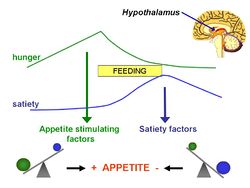Normal weight obesity: Difference between revisions
imported>Sawdah Jakda |
imported>Sawdah Jakda |
||
| Line 11: | Line 11: | ||
== '''Measuring Normal Weight Obesity''' == | == '''Measuring Normal Weight Obesity''' == | ||
[[User:Sawdah Jakda|Sawdah Jakda]] 16:04, 25 October 2011 (UTC) | |||
The gold standard definition of obesity is considered to be an excess in Body Fat (BF) but the BMI is used by clinicians and epidemiologists as a means of defining the presence of adiposity and/or obesity. The advantages of using the BMI instead of BF values is that it is a lot more simple to use and it is easy to reproduce. Studies showing the association between extreme BMI values and increased mortality further support its usage. However, this test fails to differentiate between elevated BF content and preserved/ increased lean mass in patient with a BMI below 30kg/m2, those not clinically classified as obese. | The gold standard definition of obesity is considered to be an excess in Body Fat (BF) but the BMI is used by clinicians and epidemiologists as a means of defining the presence of adiposity and/or obesity. The advantages of using the BMI instead of BF values is that it is a lot more simple to use and it is easy to reproduce. Studies showing the association between extreme BMI values and increased mortality further support its usage. However, this test fails to differentiate between elevated BF content and preserved/ increased lean mass in patient with a BMI below 30kg/m2, those not clinically classified as obese. | ||
Revision as of 10:04, 25 October 2011
For the course duration, the article is closed to outside editing. Of course you can always leave comments on the discussion page. The anticipated date of course completion is 01 April 2012. One month after that date at the latest, this notice shall be removed. Besides, many other Citizendium articles welcome your collaboration! |
The prevalence of obesity has risen rapidly over the years and shows no clear signs of slowing down. A great epidemiological representation of that can be seen in studies using the population of the US of A, collected from the 1960s to present time. It has shown that obesity in the population has increased from ~13% to almost 30%.[1]
To clinically classify a person as being obese, their Body Mass Index (BMI) must be equal to or greater than 30kg/m2. However, the spectrum of obesity is quite large. Normal Weight Obesity (NWO), found in almost half of the American adult population, is when a person has a normal BMI or normal body weight but also has a high percentage of body fat(>20% for men and >30% for women) as well as heart and metabolic disturbances. [2]
Measuring Normal Weight Obesity
Sawdah Jakda 16:04, 25 October 2011 (UTC)
The gold standard definition of obesity is considered to be an excess in Body Fat (BF) but the BMI is used by clinicians and epidemiologists as a means of defining the presence of adiposity and/or obesity. The advantages of using the BMI instead of BF values is that it is a lot more simple to use and it is easy to reproduce. Studies showing the association between extreme BMI values and increased mortality further support its usage. However, this test fails to differentiate between elevated BF content and preserved/ increased lean mass in patient with a BMI below 30kg/m2, those not clinically classified as obese.
The strong relationship between high Adiposity and metabolic disturbances makes it vital to try find a more accurate way in which to determine adiposity other than BMI.
Genetic links
Disorders linked to NWO
Treatments and Prevention
Conclusion
References
- ↑ Romero-Corral A et al. (2010) Normal weight obesity: a risk factor for cardiometabolic dysregulation and cardiovascular mortality Eur Heart J 31:737-46 PMID 19933515
- ↑ Romero-Corral A et al. (2010) Normal weight obesity: a risk factor for cardiometabolic dysregulation and cardiovascular mortality Eur Heart J 31:737-46 PMID 19933515
